Red-shouldered hawks (Buteo lineatus elegans) have nested for the past three years in Edgewood County Park, San Mateo County CA USA. These nestlings are the six, seventh, and eighth in three years! Digibird.com will maintain a nest watch with periodic updates until the nestlings fledge. Visit often and wish these nestlings (and their dedicated, frantic parents) luck! If all goes well they will fledge starting on Day 35.

Dw7834.JPG
|
June 5: Day 49-51
All three fledglings are well and are improving their flight and perching skills.
They are learning to live on their own, sort of. They now spend nights in trees,
but are not beyond daytime naps in the nest. As always, dusk is an active time. Feeding still occurs at
the nest, but is no longer cooperative--sharing is not a useful life skill for a hawk--so
the adult simply drops a snack, and the fastest fledgling eats until one of its sulking nestmates barges in. Adults have better things to do than sort out feeding; they're still the family hunters.
|
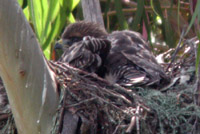
Dw7765.JPG
|
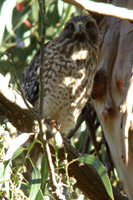
Dw7785.JPG
|
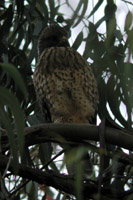
Dw7815.JPG
|
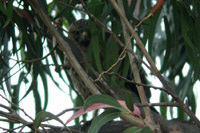
Dw7823.JPG
|
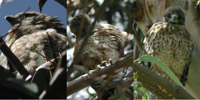
COMP.JPG
|
May 26: Day 39-41
Now six weeks after hatching, all three hawks have made their first flights. Their flight and camoflage
skills improve every day, and soon they'll be very hard to see. They are now ranging
to different trees up to 30 yards away from the nest tree. Their lives still revolve around the nest, though;
they'll be fed and sleep here for the next week or so.
|

Dw7564.JPG
|

Dw7580.JPG
|
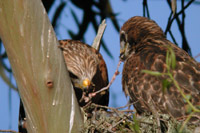
Dw7621.JPG
|
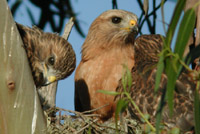
Dw7637.JPG
|

Dw7533.JPG
|
May 22: Day 35-37
The nestlings have begun fledging. First flights are to nearby branches and involve as much hopping as flying. They're not very efficient at flight yet, although their grasping skills can keep them out of serious trouble. One by one they leave the nest to spend a few precarious minutes alone. The nest is still home, however; they'll sleep and eat there for another week or so, and mom will continue to hunt and keep a close watch.
|
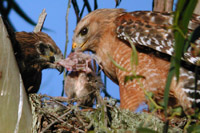
Dw7460.JPG
|

Dw7387.JPG
|

Dw7313.JPG
|
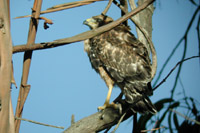
Dw7339.JPG
|
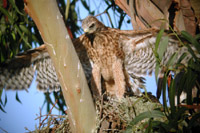
Dw7256.JPG
|
May 17: Day 30-32
Nearly full-grown and fully feathered, the three nestlings gather their strength and coordination for
fledging in a few days. They seem anxious to get going. They practice for first flight by grasping the nest and exercising their wings--a difficult task in a crowded nest! With a full set of feathers, they also devote much of their time to grooming. Eating, sleeping, and grooming--it doesn't get much better than this!
|
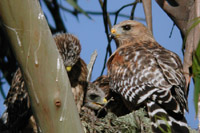
Dw7085.JPG
|
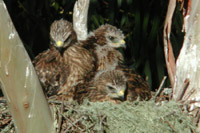
Dw7133.JPG
|
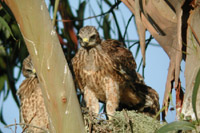
Dw7206.JPG
|

Dw7208.JPG
|
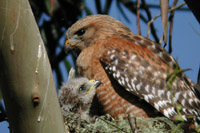
Dw7018.JPG
|
May 14: Day 27-29
Mom's job doesn't get easier as the nestlings grow older. The three nestlings need food--lots of it--and now she
must also go hunting to find it. (Her mate has been hunting continuously since hatch.) Meanwhile, the nestlings grow stronger and more alert as they approach fledging. They are nearing full size, approximately 20 times hatch weight! As big as they are, though, they still know who cares for them.
|
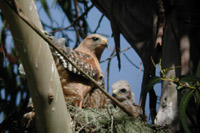
Dw6899.JPG
|
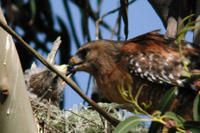
Dw6922.JPG
|
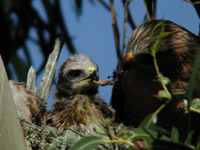
Dw6967.JPG
|
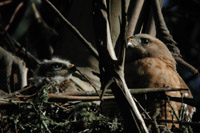
Dw7053.JPG
|
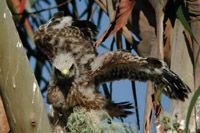
Dw6749.JPG
|
May 11: Day 24-26
Only about 10 days from fledging, the nestlings are starting to test their wings, legs, and bills. They can now feed themselves when an adult drops a tasty treat. Three nestlings require a steady stream of delicious lizards and rodents to sustain growth. When growth is this rapid, a day or two makes a real difference. Feathering is now substantially different among chicks just a day or two different in age. If food were scarce that age difference would be critical.
|

Dw6829.JPG
|
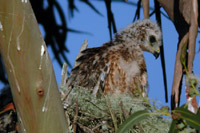
Dw6834.JPG
|

Dw6864.JPG
|
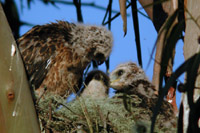
Dw6884.JPG
|
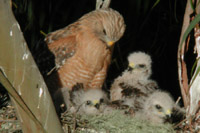
Dw6635.JPG
|
May 8: Day 21-23
The three nestlings grow rapidly. Wing and tail feathers appear first, and head feathers are
starting to show on the oldest. It's easier to believe now that these nestlings could grow into the elegant adults their parents represent. They are steadier on their feet and are starting to notice the world
outside the nest. Mom still keeps a close watch but the nest is getting small for a growing family.
|
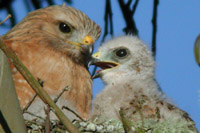
Dw6660a.JPG
|
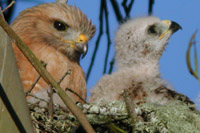
Dw6664.JPG
|
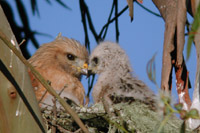
Dw6683.JPG
|
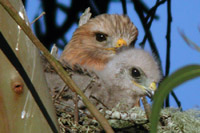
Dw6694.JPG
|
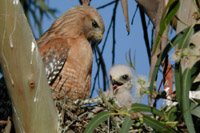
Dw6512.JPG
|
May 6: Day 19-21
Approaching the start of their third week, the chicks are entering a critical
period. Three nestlings is a severe burden for the pair; the survival of all three will
depend on the hunting success of the roving adult. So far, the chicks have grown rapidly and are
now strong enough to walk around the nest. But their favorite spot in the nest hasn't changed: right under Mom's feathers! Note the growth of primary wing and tail feathers.
|
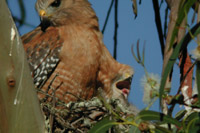
Dw6531.JPG
|
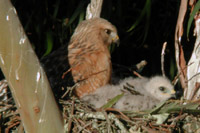
Dw6578.JPG
|
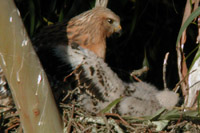
Dw6581.JPG
|
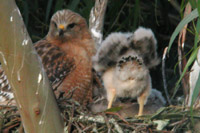
Dw6593.JPG
|
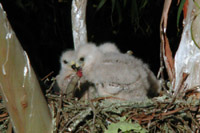
Dw6392.JPG
|
May 1: Day 14-16
At two weeks of age, the nestlings have become much stronger and more active. Note the beginnings of feathers. Although they spend much of their time slugging around the nest, they are curious about strange objects. An adult dropped this interesting item and left the nest for a few minutes. The nestlings are old enough to recognize its value, but not yet strong enough to eat it themselves. That's what mom is for!
|

Dw6323.JPG
|
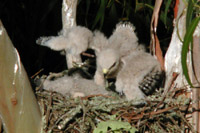
Dw6364.JPG
|
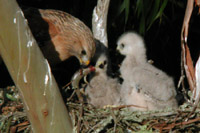
Dw6397.JPG
|
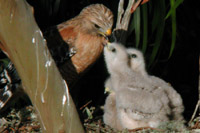
Dw6404.JPG
|
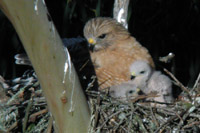
Dw6281.JPG
|
April 27: Day 10-12
The hawks hatched three chicks starting April 16. (Digibird
apologizes for the delays in updating!) All three are healthy, and hungry!, as they approach
two weeks of age. Roughly once per hour, the roving adult (male?) drops a succulent wood mouse, snake, or lizard at the nest. The brooding adult (female?) tears the food apart and distributes
it evenly between the three chicks. Note the whitewash surrounding the nest--a good sign!
|

Dw6189.JPG
|
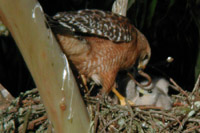
Dw6222.JPG
|
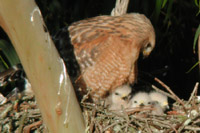
Dw6263.JPG
|
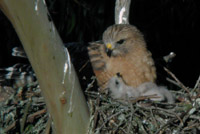
Dw6273.JPG
|
April 18: Day 1-3
Newly hatched chicks, about 30 grams (1 oz) each. (There are three.)

Dw5948.JPG
That's amore! |

Dw5961.JPG
|
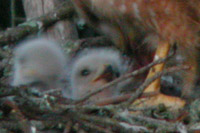
Dw5971.JPG
|
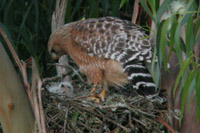
Dw5989.JPG
|
All images copyright Digibird.com; unauthorized use or reproduction prohibited.
Back to Digibird home